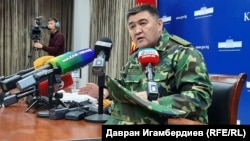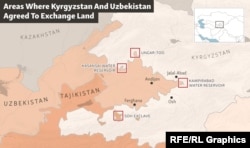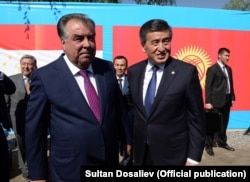The head of Kyrgyzstan’s security service returned from border talks with Uzbekistan last week claiming that all remaining demarcation disputes between the two former Soviet republics have been “resolved 100 percent.”
But this week, the same official has been telling residents of some disputed areas that it is not completely a done deal.
Kamchybek Tashiev, the head of Kyrgyzstan’s State Committee for National Security (UKMK), made the claim on March 26 after two days of talks in neighboring Uzbekistan -- saying “the issue of the borders with Uzbekistan has been resolved 100 percent.… No issues remain.”
Tashiev said agreement was reached for a complicated territorial swap involving land and water rights to settle, once and for all, the border disputes both sides have wrestled with since the disintegration of the Soviet Union in 1991.
It was a stunning announcement after nearly 30 years of border talks that had appeared deadlocked over several areas where neither side was willing to make concessions.
But during the past week, as Tashiev traveled to Kyrgyzstan’s southern provinces to discuss details of the deal with residents in the affected areas, it quickly became apparent that the border issue with Uzbekistan is not “100 percent” resolved.
In the Uzgen district of Osh Province on May 30, the UKMK chief spoke about the village of Birlik in the Kadamzhai district, which borders the Uzbek exclave of Soh.
Earlier in the day, Tashiev had been to Birlik -- the scene of clashes in May 2020 that destroyed several homes and vehicles and left more than 200 people injured. Tashiev views the cause of the violence to be the shared use of a large spring by inhabitants of the Uzbek exclave and neighboring Kyrgyz villages.
“Concerning this area, there was no final decision. To be candid, we did not reach an agreement on this section, including adjacent territory,” Tashiev said.
Tashiev mentioned the settlement of Chesme in Kyrgyzstan and the neighboring settlement of Chasma in the Soh exclave. Both were at the epicenter of the May 2020 clashes.
“There are villages there in which thousands of people live, and there are thousands of hectares [of land], and the fate of these need to be resolved,” Tashiev said.
“Of course, if the people are against [the land-swap agreements], it is possible that some will not be implemented,” Tashiev also said.
Discontent about the land-swap agreements has already surfaced.
On April 1, Kyrgyz residents of the Kara-Suu district of Osh Province protested against part of the agreement that would hand over 50 hectares of land from the village of Yntymak to Uzbekistan.
Tashiev has stressed that Kyrgyzstan will receive some 13,000 square hectares of disputed land under the agreement he announced on March 26. He also listed those areas involved in the land-swap deal.
This breakthrough came after Kyrgyz President Sadyr Japarov made an official visit to Uzbekistan on March 11-12 and met with Uzbek President Shavkat Mirziyoev.
Border issues were one of the main topics of their talks. Mirziyoev said the two sides wanted to complete talks on demarcation within three months.
The task of relocating people will be much easier for Mirziyoev because his government has a much tighter grip on society than has been the case with the Kyrgyz government. Japarov came to power after protests in early October 2020 ousted the previous government.
The Kyrgyz president’s legitimacy is still debatable, despite his victory in a snap presidential election on January 10.
Some doubt Japarov can survive his full term in office given the daunting number of problems he faces in a country where protests have led to the ouster of three presidents since 2005.
Japarov’s government needs some political victories.
It could be that Tashiev, who once said Kyrgyzstan would never cede even one square centimeter of its territory, has oversold the land-swap deal.
Nevertheless, the agreement represents significant progress for both Kyrgyzstan and Uzbekistan -- even if it hasn’t resolved 100 percent of the remaining border issues.
Upcoming border talks with Tajikistan are unlikely to be as successful as Kyrgyzstan’s negotiations with Uzbekistan.
Tashiev’s suggestion on March 26 that Tajikistan might make a land-swap deal over its large Vorukh exclave was met with silence by Tajik authorities.
Then, on March 31, RFE/RL’s Tajik Service reported that President Emomali Rahmon had scheduled a visit to Vorukh for April 4.
Rahmon had met in July 2019 with Kyrgyzstan’s then-President Sooronbai Jeenbekov to discuss their border issues. It was Rahmon’s first visit to Vorukh in 26 years. So his sudden return there less than two years later raises suspense about the aim of his visit.
Meanwhile, Kyrgyzstan’s military and security forces on April 1 started a three-day training exercise in Batken Province in the area near the Tajik border.
In the end, none of these border disputes can be finally and peacefully demarcated without the participation and agreement of border area residents.
Tashiev mentioned when speaking about Chesme that part of the problem with exchanging land there is the presence of an old cemetery.
The major obstacles to drawing definitive borders appear to be related to generational ties to the land by local residents -- such as cemeteries or trees planted and agriculture fields tilled by grandfathers and great-grandfathers.
Concerns of residents that the land they receive in a swap deal will not be as fertile as the land they surrender also appear to be a remaining obstacle to finalizing the lines on the map.










